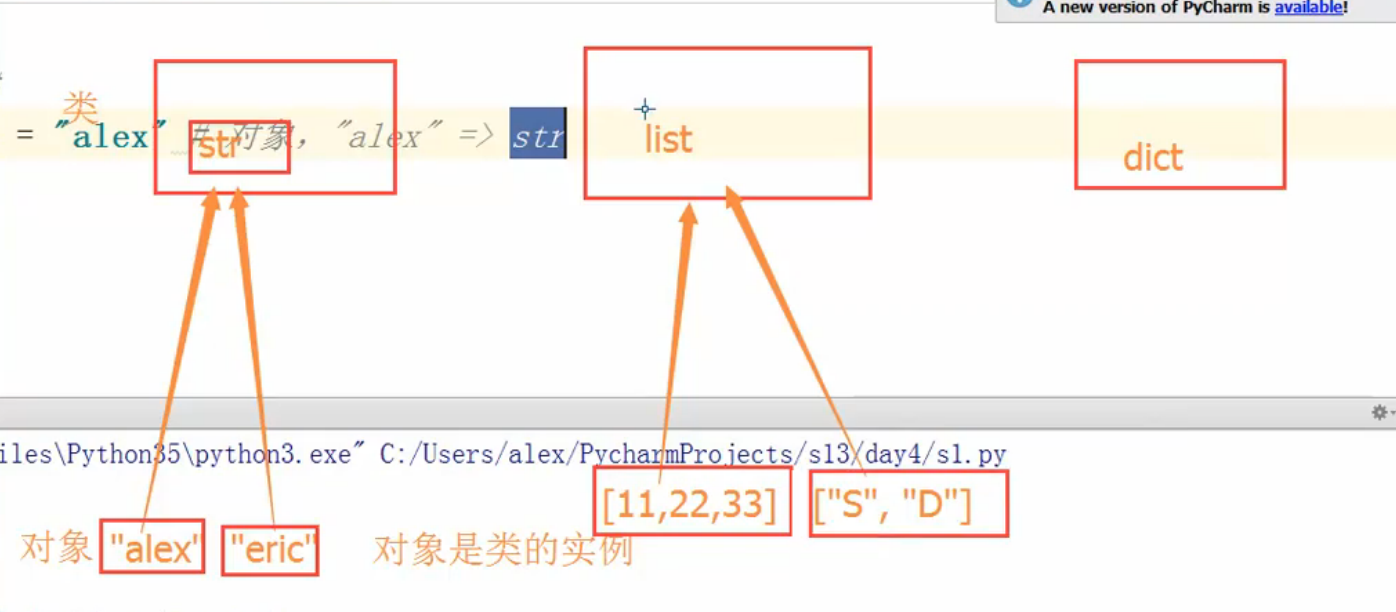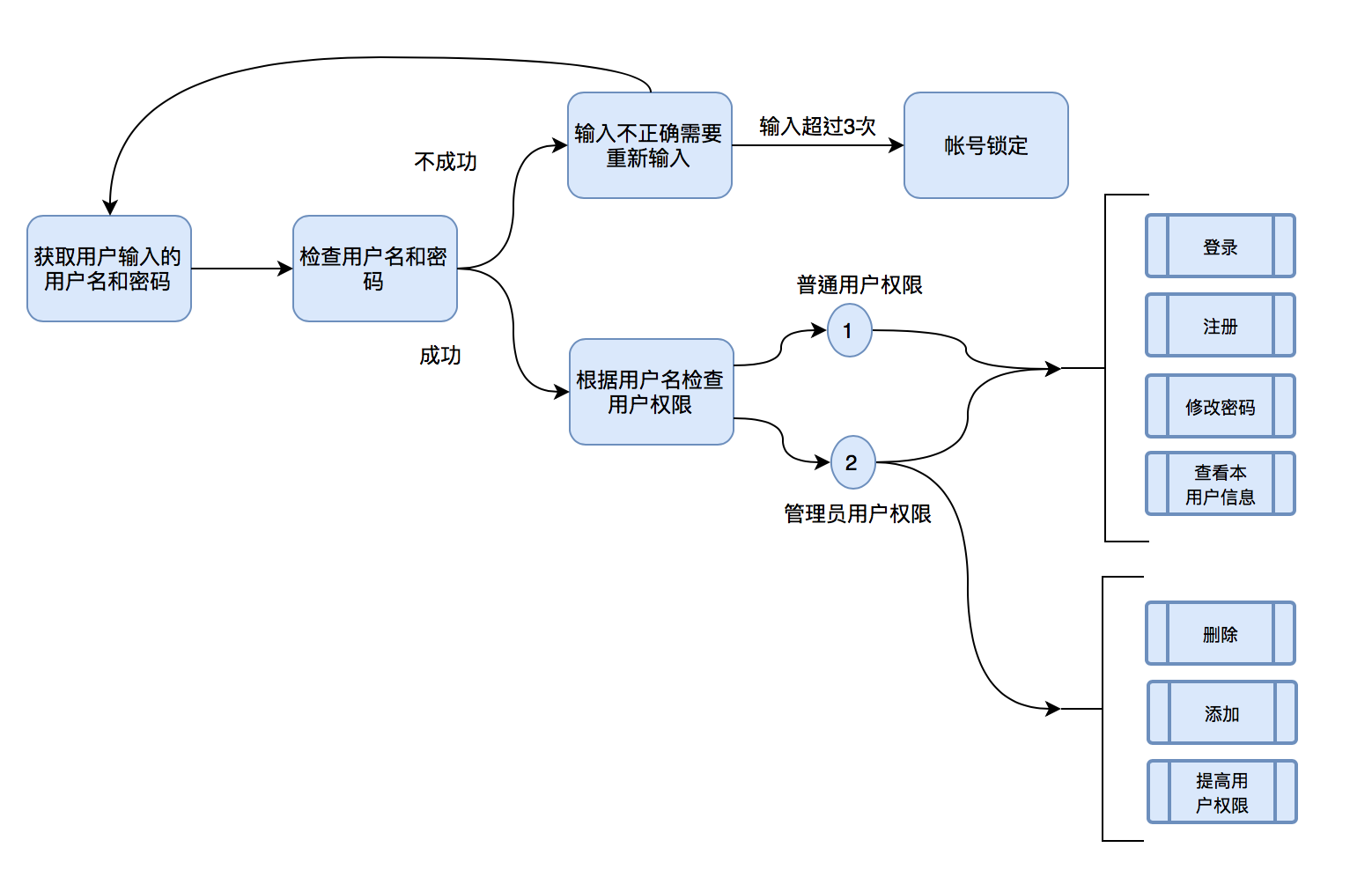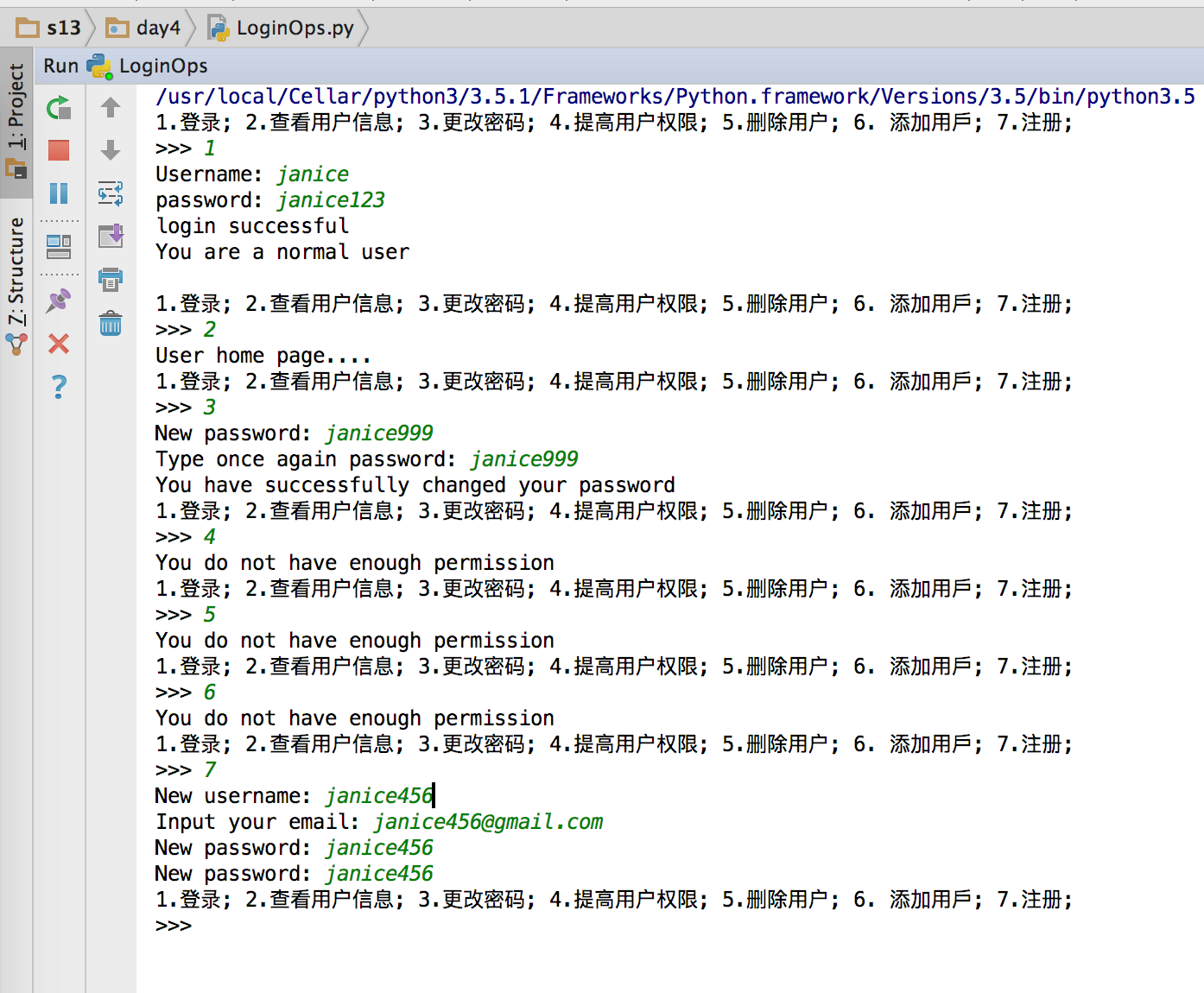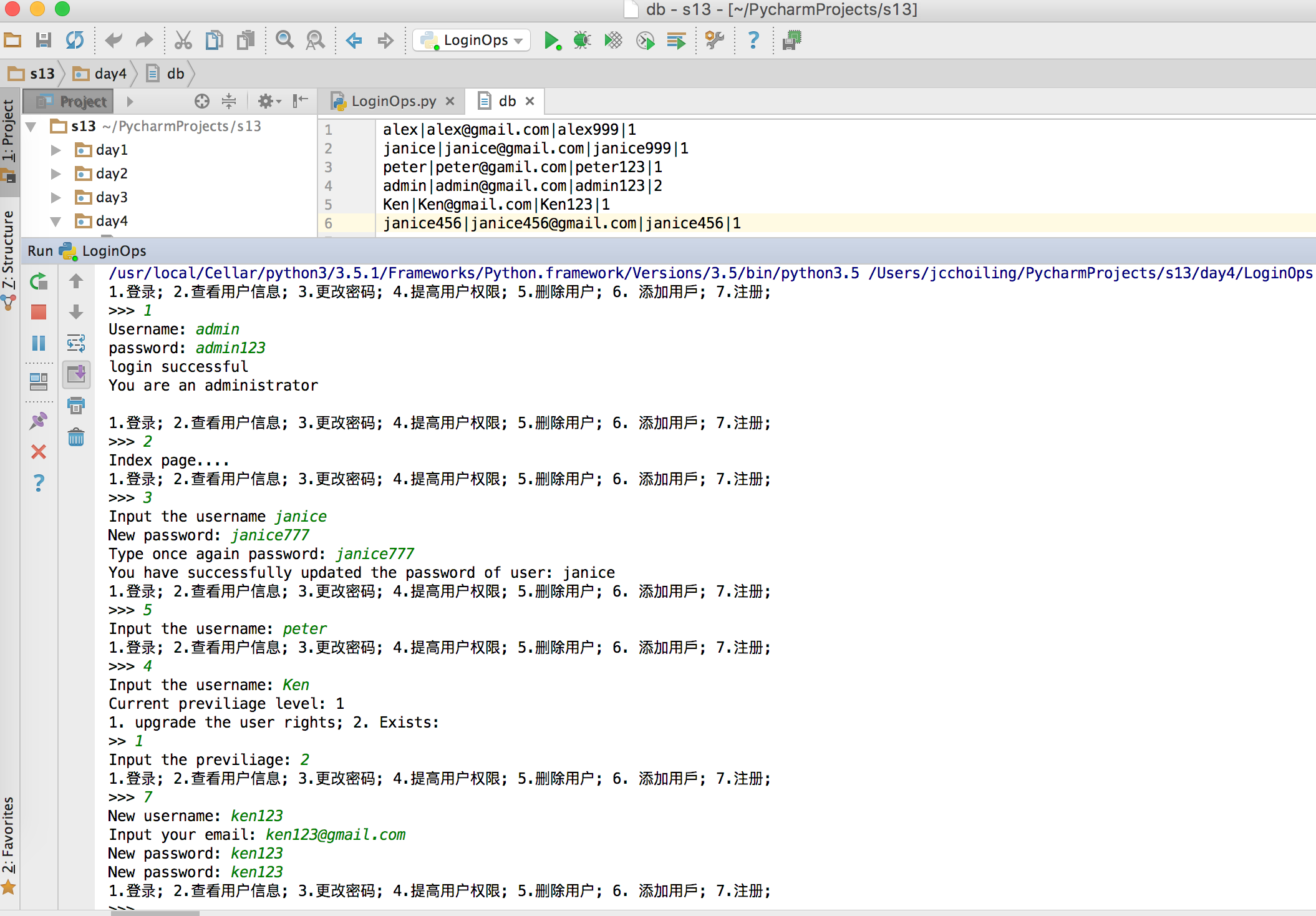本課主題
- 內置函数介紹和操作实战
- 装饰器介紹和操作实战
- 本周作业
內置函数介紹和操作实战
返回Boolean值的內置函数
- all( ): 接受一個可以被迭代的對象,如果函数裡所有為真,才會真;有一個是假就會返回假‧
 all( )函数例子
all( )函数例子>>> a1 = all([1,2,3,4]) >>> print(a1) True >>> a2 = all([1,2,3,0]) >>> print(a2) False >>> a3 = all([1,2,3,[]]) >>> print(a3) False
- any( ): 接受一個可以被迭代的對象,如果函数裡只要有真,就會真;所有為假才會返回假‧
 any( )函数例子
any( )函数例子>>> n1 = any([1,2,3,4]) >>> print(n1) True >>> n2 = any([1,2,3,0]) >>> print(n2) True >>> n3 = any([1,2,3,[]]) >>> print(n3) True >>> n4 = any([0,(),{},[]]) >>> print(n4) False
- bool( ): 判断什麼時候是真,什麼時候是假
 bool( )函数例子
bool( )函数例子>>> print(bool(0)) False >>> print(bool(None)) False >>> print(bool("")) False >>> print(bool([])) False >>> print(bool({})) False >>> print(bool(())) False >>> print(bool(" ")) True >>> print(bool(1)) True >>> print(bool(-1)) True
面向对象相关的内置函数
- ascii( ): 它會自动执行对象里的 __repr___方法,然後取 __repr___方法裡的值。
 ascii( )函数例子
ascii( )函数例子>>> class Foo: ... def __repr__(self): ... return "111" ... >>> n = ascii(Foo()) #自动执行对象里的 __repr___方法 >>> print(n)
- staticmethod( ):
- repr( ):
 repr( )函数例子
repr( )函数例子>>> class Foo: ... def __repr__(self): ... return "111" ... >>> n = repr(Foo()) #自动执行对象里的 __repr___方法 >>> print(n)
- object( ):
- property( ):
- isinstance( ): 判断某一个对象是谁的实例,对象和类是什么关系,对于 str 这个类可以创建,执行功能的时候,都会到 str 里找,对象跟类是有关系的。另外一种说法是对象是类的实例,

 isinstance( )函数例子
isinstance( )函数例子s = "alex" r1 = isinstance(s, str) #判断对象是否是 str 的事例 print(r1) #True r2 = isinstance(s, dict) #判断对象是否是 dict 的事例 print(r2) #False r3 = isinstance(s, list) #判断对象是否是 list 的事例 print(r3) #False
- super( ):
返回数字的内置函数
- round( ):四写五入传进来的数字
- abs( ): 取绝对值
 abs( )例子
abs( )例子>>> n = abs(-1) >>> print(n) 1
- divmod( ):计算余数
 divmod( )函数例子
divmod( )函数例子>>> r = divmod(97,10) # 會返回 Tuple >>> print(r) (9, 7) >>> print(r[0]) >>> print(r[1]) #余數 >>> (n1,n2) = divmod(97,10) # 會返回 Tuple >>> print(n1) >>> print(n2) #余數
- len( )
 len( )函数例子
len( )函数例子#Python2 >>> s = "你好" >>> print(len(s)) #默认是按字节来判断长度 #Python3 >>> s = "你好" >>> print(len(s)) #默认是按字符来判断长度 >>> s = "你好" >>> s2 = bytes(s, encoding='utf-8') #Python3也可以按字节找 >>> print(len(s2))
- pow( )
 pow( )函数例子
pow( )函数例子>>> r1 = 2**10 >>> r2 = pow(2,10) >>> print(r1) 1024 >>> print(r2) 1024
- enumerate( )
 enumerate( ) 例子
enumerate( ) 例子>>> company = ["google", "facebook", "baidu", "alibaba", "yahoo", "IBM", "apple", "amazons"] >>> for com in enumerate(company): ... print(com) ... (0, 'google') (1, 'facebook') (2, 'baidu') (3, 'alibaba') (4, 'yahoo') (5, 'IBM') (6, 'apple') (7, 'amazons') >>> for com in enumerate(company, 10): ... print(com) ... (10, 'google') (11, 'facebook') (12, 'baidu') (13, 'alibaba') (14, 'yahoo') (15, 'IBM') (16, 'apple') (17, 'amazons')
字符、字节相关的内置函数
- bin( ): 这个函数接受一个十进制,然后转换成二进制
 bin( )例子
bin( )例子>>> print(bin(5)) 0b101
- oct( ): 这个函数接受一个十进制,然后转换成八进制
 oct( )例子
oct( )例子>>> print(oct(9)) 0o11
- hex( ): 这个函数接受一个十进制,然后转换成十六进制
 hex( )例子
hex( )例子>>> print(hex(15)) 0xf
- 字節
 字节
字节s = "李杰" #二进制:10101010 10101010 10101010 10101010 10101010 10101010 #十进制: 23 23 23 23 23 23 #十六进制: 2f 2g 2e 2d 2c 2f
如果想把一个字节串转换成字节类型需要调用 bytes( )函数,然后加上要转换的字符串,还有编码。如果想把字符串转换成字节类型,不同的编码会有不同大小的字节,它的二进制是表现形式
 bytes( )例子
bytes( )例子>>> bytes("李杰",encoding='utf-8') b'xe6x9dx8exe6x9dxb0' >>> bytes("李杰",encoding='gbk') b'xc0xeexbdxdc'
- 字节又怎么转换成字符串
 str( )函数例子
str( )函数例子>>> n = bytes("李杰",encoding='utf-8') >>> n b'xe6x9dx8exe6x9dxb0' >>> ret = str(n,encoding='utf-8') >>> print(ret) 李杰
- chr( ): 数字转换成字母
 chr( )函数例子
chr( )函数例子>>> r = chr(65) #把一个数节转换成字母 >>> print(r) #A A
- ord( ): 字母转换成数字
 ord( )函数例子
ord( )函数例子>>> n = ord("A") #把一个字母转换成数字 >>> print(n) #65 65
其他的内置函数
对于一个文件它保存是以0101010的方式保存,如果想操作文件,应该需要把它读取到内存里,Python 读取文章的内容到内存,内部会把一个字符串给你编译成一个特殊的代码,第三步才执行代码。 Compile( ) 就是用来编译代码
Compile( ) 和 exec( ):如果是 exec 的话,会给你编译Python 一样的代码,可以执行所有 Python 的东西。

>>> s = "print(123)" #这个字符串会放内存 >>> r = compile(s,"<string>","exec") >>> print(r) <code object <module> at 0x10345f810, file "<string>", line 1> >>> exec(r) 123
如果是 single 的话,会给你编译成单行的 Python 程序
如果是 eval 的话,会给你编译成表达式,拿到一个字符串,变成了表达式然后去执行它,eval 是有返回值的,它会执行程序并可以把结果返回给另外一个参数。

s2 = "8*8" ret = eval(s2) print(ret) #64
dir( ): 快速获取一下一个类提供了哪些功能

>>> print(dir(dict)) ['__class__', '__contains__', '__delattr__', '__delitem__', '__dir__', '__doc__', '__eq__', '__format__', '__ge__', '__getattribute__', '__getitem__', '__gt__', '__hash__', '__init__', '__iter__', '__le__', '__len__', '__lt__', '__ne__', '__new__', '__reduce__', '__reduce_ex__', '__repr__', '__setattr__', '__setitem__', '__sizeof__', '__str__', '__subclasshook__', 'clear', 'copy', 'fromkeys', 'get', 'items', 'keys', 'pop', 'popitem', 'setdefault', 'update', 'values']
help( ): 功能详细显示出来

>>> print(help(list)) class list(object) | list() -> new empty list | list(iterable) -> new list initialized from iterable's items | | Methods defined here: | | __add__(self, value, /) | Return self+value. | | __contains__(self, key, /) | Return key in self. | | __delitem__(self, key, /) | Delete self[key]. | | __eq__(self, value, /) | Return self==value. | | __ge__(self, value, /) | Return self>=value. | | __getattribute__(self, name, /) | Return getattr(self, name). | | __getitem__(...) | x.__getitem__(y) <==> x[y] | | __gt__(self, value, /) | Return self>value. | | __iadd__(self, value, /) | Implement self+=value. | | __imul__(self, value, /) | Implement self*=value. | | __init__(self, /, *args, **kwargs) | Initialize self. See help(type(self)) for accurate signature. | | __iter__(self, /) | Implement iter(self). | | __le__(self, value, /) | Return self<=value. | | __len__(self, /) | Return len(self). | | __lt__(self, value, /) | Return self<value. | | __mul__(self, value, /) | Return self*value.n | | __ne__(self, value, /) | Return self!=value. | | __new__(*args, **kwargs) from builtins.type | Create and return a new object. See help(type) for accurate signature. | | __repr__(self, /) | Return repr(self). | | __reversed__(...) | L.__reversed__() -- return a reverse iterator over the list | | __rmul__(self, value, /) | Return self*value. | | __setitem__(self, key, value, /) | Set self[key] to value. | | __sizeof__(...) | L.__sizeof__() -- size of L in memory, in bytes | | append(...) | L.append(object) -> None -- append object to end | | clear(...) | L.clear() -> None -- remove all items from L | | copy(...) | L.copy() -> list -- a shallow copy of L | | count(...) | L.count(value) -> integer -- return number of occurrences of value | | extend(...) | L.extend(iterable) -> None -- extend list by appending elements from the iterable | | index(...) | L.index(value, [start, [stop]]) -> integer -- return first index of value. | Raises ValueError if the value is not present. | | insert(...) | L.insert(index, object) -- insert object before index | | pop(...) | L.pop([index]) -> item -- remove and return item at index (default last). | Raises IndexError if list is empty or index is out of range. | | remove(...) | L.remove(value) -> None -- remove first occurrence of value. | Raises ValueError if the value is not present. | | reverse(...) | L.reverse() -- reverse *IN PLACE* | | sort(...) | L.sort(key=None, reverse=False) -> None -- stable sort *IN PLACE* | | ---------------------------------------------------------------------- | Data and other attributes defined here: | | __hash__ = None
filter( ): 函数返回 True,将元素添加到结果中,可以有兩個方法
- 先不用Python 的内置函数,都可以自己写一个有 filter 功能的函数
 自定义有filter()功能的函数
自定义有filter()功能的函数>>> def f1(args): ... results = [] ... for item in args: ... if item > 22: ... results.append(item) ... return results >>> li = [11,22,33,44,55,66,77,88,99] >>> ret = f1(li) >>> print(ret) [33, 44, 55, 66, 77, 88, 99]
- 然後現在的調用 Python 的內置函数:filter( ),filter(func,iter)
filter(func,iter) #func 接收一个函数 #iter 接收一个可迭代的对象
 filter( )函数例子
filter( )函数例子>>> def f2(a): ... if a > 22: ... return True ... >>> li = [11,22,33,44,55] >>> ret = filter(f2,li) #filter(func(),Iterator) >>> print(list(ret)) [33, 44, 55] # filter内部, 循环第二个参数 # results = [] # for item in 第二个参数: # r = 第一個参数(item) # if r: # results(item) # return results
- 调用 lambda 表达式也可以实现相同的功能
 lambda表达式的filter( )函数例子
lambda表达式的filter( )函数例子#lambda 內部會幫自動 return # f1 = lambda a: a > 30 # ret = f1(90) li = [11,22,33,44,55] results = filter(lambda a: a > 33,li) print(list(results)) #[44, 55]
map( ):帮你遍历数组里的每一个元素,然后基于自己写的逻辑对数组进行处理。 map也会接收一个函数和一个可迭代的对象。
map(func,iter) #func 接收一个函数 #iter 接收一个可迭代的对象
- 先不用Python 的内置函数,都可以自己写一个有 map 功能的函数
 自定义有map()功能的函数
自定义有map()功能的函数>>> li = [11, 22, 33, 44, 55] >>> def f2(a): ... return a + 100 ... >>> results = map(f2,li) >>> print(list(results)) [111, 122, 133, 144, 155]
- 调用 lambda 表达式也可以实现相同的功能
 lambda表达式的map( )函数例子
lambda表达式的map( )函数例子li = [11, 22, 33, 44, 55] results = map(lambda a:a+100, li) print(list(results)) #[111, 122, 133, 144, 155]
在 Spark 裡用了很多 lamdba 表達式

from __future__ import print_function import sys from operator import add from pyspark.sql import SparkSession if __name__ == "__main__": if len(sys.argv) != 2: print("Usage: wordcount <file>", file=sys.stderr) exit(-1) spark = SparkSession .builder .appName("PythonWordCount") .getOrCreate() lines = spark.read.text(sys.argv[1]).rdd.map(lambda r: r[0]) counts = lines.flatMap(lambda x: x.split(' ')) .map(lambda x: (x, 1)) .reduceByKey(add) output = counts.collect() for (word, count) in output: print("%s: %i" % (word, count)) spark.stop()
Zip( ):两个或以上的列表,各自列表的第 x个元素右起来组成新的元组

l1 = ["Python", 44, 11, 33, 22] l2 = ["is", 44, 11, 33, 22] l3 = ["Fun", 44, 11, 33, 22] r = zip(l1,l2,l3) temp = list(r)[0] ret = " ".join(temp) print(ret) #Python is Fun
locals( ): 代表所有的局部变量,都会放在这个函数里
global( ): 代表所有的全区变量,都会放在这个函数里

>>> NAME = "Janice" >>> def show(): ... a=123 ... >>> def show(): ... a=123 ... print(locals()) ... print(globals()) ... >>> show() {'a': 123} {'a3': False, 'add': <function <lambda> at 0x1034ab598>, 'n1': 9, 'r': (9, 7), 'li': [11, 22, 33, 44, 55], 'fruit': 'apple', '__package__': None, 'n3': True, 'results': <map object at 0x10376b668>, 'n4': False, '__name__': '__main__', 'NAME': 'Janice', 'Foo': <class '__main__.Foo'>, '__doc__': None, 'f1': <function f1 at 0x1034ab620>, '__loader__': <class '_frozen_importlib.BuiltinImporter'>, 'f2': <function f2 at 0x1034ab510>, '__spec__': None, 'ret2': 110, '__builtins__': <module 'builtins' (built-in)>, 'name': 'apple', 'show': <function show at 0x10375c268>, 's': 'print(123)', 'n2': 7, 'a2': False, 'ret': <filter object at 0x10376b7f0>, 'a1': True, 'n': b'xe6x9dx8exe6x9dxb0'}
hash( ): 生成一個hash值,它在內部經常用,一般用於字典的 Key 來保存

>>> s = "ffffffffffffffffffffffffffffffffffffffffffffffffffffffff" #不会把整个字符串存储在内部里 >>> dic = {"ffffffffffffffffffffffffffffffffffffffffffffffffffffffff" : 1} #会首先把它转换成 hash 值然后以字典的 Key 方式存储在内部里 >>> hash("ffffffffffffffffffffffffffffffffffffffffffffffffffffffff") 7896373676960469870 >>> dic = {"7896373676960469870" : 1} >>> dic {'7896373676960469870': 1}
memoryview( ):
callable( ):
vars( ):
sorted( ): Python 有两个内置的排序函数,一种是调用 sorted(a) 函数但并不改变原来实例的顺序;另一种是调用 a.sort( )函数,这会改变原来目标的顺序

>>> a = [2, 4, 3, 5, 1] >>> sorted(a) [1, 2, 3, 4, 5] >>> a [2, 4, 3, 5, 1] >>> a.sort() >>> a [1, 2, 3, 4, 5]
装饰器的介紹和操作实战
单层装饰器

>>> def outer(): ... print("outer.....") ... >>> def f1(): ... outer() ... print("f1 ") ... >>> def f2(): ... outer() ... print("f2 ") ... >>> def f100(): ... outer() ... print("f100 ") ... >>> ff1 = f1() outer..... f1 >>> ff2 = f2() outer..... f2 >>> ff100 = f100() outer..... f100
- 开放封闭原则:对于类或者是函数的内部,对所有人来说是封闭的,你改函数的时候不要在函数内部改,意思是说如果需要统一修改或者是添加功能的话,不可以在类或者是函数的内部直接改,对类或者是函数的外部是开放的。不影响函数的执行下,在外部添加一个新功能
- 应用埸景:在不改变函数内容的前题下,在它的参数不变的基础上,在它的之前或者是之后统一的做一些操作为什么要使用装饰器,因为想在执行函数之前先做一些操作,然后在执行函数之后又做一些操作。我通过一些语法,在你执行函数之前做一些操作,之后又做一些操作。
 装饰器例子[函数執行之前添加信息]
装饰器例子[函数執行之前添加信息]>>> def outer(func): ... def inner(): ... print("log") ... return func() ... return inner ... >>> @outer #在函数的外部添加一个 outer 函数 ... def f1(): ... print("f1") ... >>> f1() log f1
 装饰器例子[函数執行之后添加信息]
装饰器例子[函数執行之后添加信息]>>> def outer(func): ... def inner(): ... print("decorator: before.....") ... r = func() ... print("decorator: after..... ") ... return r ... return inner ... >>> @outer ... def f1(): ... print("f1") ... >>> ff1 = f1() decorator: before..... f1 decorator: after.....
- 对函数是一个整体来说是可以把它当参数传到另外一个函数里
 函数当参数传到另外一个函数里
函数当参数传到另外一个函数里def f1(): print(123) def f2(xxx): xxx() f2(f1) #123
 函数是参数原理解析
函数是参数原理解析# 首先定义了 outer 函数 # 调用装饰器时会把f1这个整体当做参数传到 outer,然后把outer函数的返回再赋值给f1,这相当于 # def outer(): # return "123" # # f1 = "123" def outer(func): return "123" @outer def f1(): print("f1") f1 print(f1,type(f1)) #123 <class 'str'>
- 在你執行函数之前做一些操作,之後又做一些操作,装饰器有兩個主要的功能,
功能一、自动执行 outer 函数并且将下面的函数名 f1当作参数传
功能二、将 outer 函数的返回值返回,重新赋值给 f1
def outer(func): def inner(): print("before") func() #执行原来的函数 e.g. f1() print("after") return inner @outer def f1(): print("F1") - 也可以在原来的函数传入参数,当原函数有返回值时,在执行装饰器时也需要确保有返回值
 装饰器例子[有一個参数]
装饰器例子[有一個参数]def outer(func): def inner(a): print("before") r = func(a) #执行原来的函数 e.g. f1() print("after") return r return inner # @ + 函数 然后放在一个函数上面 # 功能: #- 自动执行 outer 函数并且将下面的函数名 f1当作参数传 #- 将 outer 函数的返回值返回,重新赋值给 f1 @outer def f1(args): print(args) return ("返回了") @outer def f2(): print("F2")
 装饰器例子[多个参数]
装饰器例子[多个参数]def outer(func): def inner(*args, **kwargs): print("before") r = func(*args, **kwargs) #执行原来的函数 e.g. f1() print("after") return r return inner # @ + 函数 然后放在一个函数上面 # 功能: #- 自动执行 outer 函数并且将下面的函数名 f1当作参数传 #- 将 outer 函数的返回值返回,重新赋值给 f1 @outer def f1(args): print(args) return ("返回了") @outer def f2(arg1, arg2): print(arg1,arg2)
- 程序执行的步骤


import time def log_calls(func): def wrapper(*args, **kwargs): now = time.time() print("Calling {0} with {1} and {2}".format(func.__name__, args, kwargs)) return_value = func(*args, **kwargs) # call test1(1,2,3) function print("Executed {0} in {1}ms".format(func.__name__, time.time() - now)) return return_value return wrapper #log_calls(test1) @log_calls def test1(a,b,c): print(" test1 called") #log_calls(test2) @log_calls def test2(a,b): print(" test2 called") #log_calls(test3) @log_calls def test3(a,b): print(" test3 called") time.sleep(1) # test1 = log_calls(test1) # test2 = log_calls(test2) # test3 = log_calls(test3) test1(1,2,3) # wrapper(*args, **kwargs) test2(4,b=5) test3(6,7) """ Calling test1 with (1, 2, 3) and {} test1 called Executed test1 in 0.00011897087097167969ms Calling test2 with (4,) and {'b': 5} test2 called Executed test2 in 2.193450927734375e-05ms Calling test3 with (6, 7) and {} test3 called Executed test3 in 1.0049281120300293ms """
双层装饰器
[更新中]
案例实战
[更新中]

#!/usr/bin/env python # -*- coding: utf-8 -*- # Author: Janice Cheng LOGIN_USER = {"is_login": False} def outer(func): def inner(*args, **kwargs): if LOGIN_USER["is_login"]: r = func() return r else: print("Please login First") return inner @outer def order(): print("Welcome {} ".format(LOGIN_USER["current_user"])) @outer def changepwd(): print("Welcome {} ".format(LOGIN_USER["current_user"])) @outer def manager(): print("Welcome {} ".format(LOGIN_USER["current_user"])) def login(user,pwd): if user == "janice" and pwd == "jc123456": LOGIN_USER["is_login"] = True LOGIN_USER["current_user"] = user print("login successful ") def main(): while True: inp = input("1. 后台管理; 2.登录 >> ") if inp == '1': manager() elif inp == '2': username = input("Username: ") password = input("password: ") login(username,password) main()
本周作业
优化用户管理程序
普通用户: 登录,注册,修改密码,查看本用户信息
管理员用户:登录,注册,修改密码,查看本用户信息
删除、添加普通用户
修改普通用户密码
查看所有普通用户,按照指定关键字搜索用户信息
提高用户权限
* 用户信息需要存储在文件:alex|123|alex@gmail.com|1
* 权限要用装饰器来实现
程序流程图

程序结果


参考资料
金角大王:
银角大王:Python开发【第四篇】:Python基础之函数
